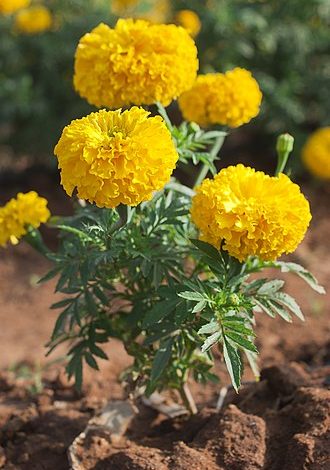Tagetes

Tagetes is a genus[2] of annual or perennial, mostly herbaceous plants in the sunflower family Asteraceae. They are among several groups of plants known in English as marigolds. The genus Tagetes was described by Carl Linnaeus in 1753.[3][4]
The plants are native to the Americas, growing naturally from the southwestern United States into South America, but some species have become naturalized around the world. One species, T. minuta, is considered a noxious invasive plant in some areas.[2]
Tagetes species vary in size from 0.1 to 2.2 m tall. Most species have pinnate green leaves. Blooms naturally occur in golden, orange, yellow, and white colors, often with maroon highlights. Floral heads are typically (1-) to 4–6 cm diameter, generally with both ray florets and disc florets. In horticulture, they tend to be planted as annuals, although the perennial species are gaining popularity. They have fibrous roots.[citation needed]
Depending on the species, Tagetes species grow well in almost any sort of soil. Most horticultural selections grow best in soil with good drainage, and some cultivars are known to have good tolerance to drought.[5]
The name Tagetes is from the name of the Etruscan Tages, born from the plowing of the earth.[6] It likely refers to the ease with which plants of this genus come out each year either by the seeds produced in the previous year, or by the stems which regrow from the stump already in place.[7]
The common name in English, marigold, is derived from Mary’s gold, a name first applied to a similar plant native to Europe, Calendula officinalis.[citation needed]
The most commonly cultivated varieties of Tagetes are known variously as African marigolds (usually referring to cultivars and hybrids of Tagetes erecta), or French marigolds (usually referring to hybrids and cultivars of Tagetes patula, many of which were developed in France). The so-called signet marigolds are hybrids derived mostly from Tagetes tenuifolia.[citation needed]
